Maranta - Prayer Plant

Maranta (Prayer Plant) is a decorative foliage house plants belonging to the Marantaceae family. This family comprises around 25 plant species, mainly herbaceous and low-growing, naturally found in the swampy forests of Central and South America.
Marantas are appealing due to the unique coloring of their leaves. Marantaceae leaves come in elongated-elliptical or oval shapes with striking patterns. Dark green stripes alternate with pink or pale green, and reddish-brown velvety spots accentuate the light green veins on Maranta leaves.
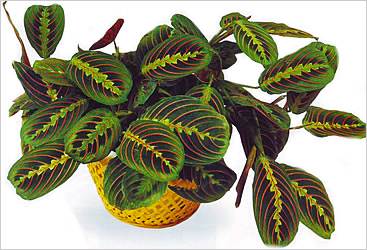
These perennial decorative leafy houseplants have an interesting feature: the leaf blades of the Maranta can change their orientation depending on the lighting conditions. In favorable conditions, they spread almost horizontally, while in low light in the evening, they lift upwards and fold together. This distinctive feature has earned Maranta the nickname "Prayer Plant." The flowers are usually small, white, gathered in spike-like inflorescences, and Marantas have tuberous thickenings on their roots.
Species:
- Maranta leuconeura E. Morren Round-elliptical leaves, 10-15 cm long and 5-9 cm wide, heart-shaped at the base, dark green on top with a silver stripe in the middle, silver-white side veins, and light green decorative patterns below.
- Maranta leuconeura var. Kerchoveana: Grey-green on the underside and bright green on top with velvety brown or dark green spots.
- Maranta leuconeura var. massangeana: Similar to Kerchoveana, but with olive-brown spots.
- Maranta tricolor: Leaves with light small spots along the central vein and striking, curving bright red veins on the upper side, and purple on the lower side.
- Maranta arundinacea: Grows in tropical moist forests in Central and South America. A compact shrub 0.6-1.2 m tall (stems dry up in winter) with thick tuberous roots. Long (up to 25 cm), egg-shaped, pointed at the top, dark green leaves with a bluish tint on the underside. White flowers.
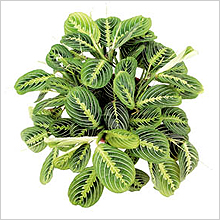
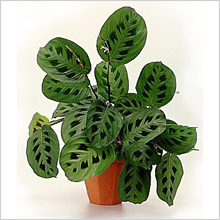

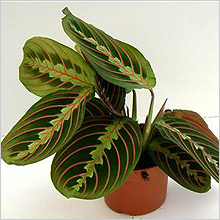
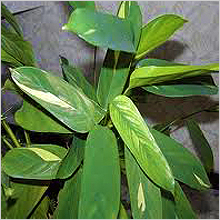
Caring for Prayer Plant Indoors
Light: Ideal locations for Maranta in your home are north, east, or west-facing windows, as it prefers diffused light and can tolerate light shade. Placing it on a table or shelf near a southern window is also suitable. Maranta leaves may burn in bright sunlight. Artificial lighting is also sufficient.
Temperature: Average to warm (65-80°F/18-27°C) year-round. Maranta dislikes drafts.
Humidity: Humidity is crucial for Prayer Plant and other Marantaceae family plants. If the air is too dry, leaf tips may dry out. Maranta thrives better when placed among other houseplants or near a water source, such as an aquarium.You can take the plant outdoors in the summer, but it should be placed in a shaded area.
Water: Water generously with warm, soft water, keeping the soil consistently moist but avoiding waterlogged conditions. Reduce watering in autumn and winter.
Repotting: Repot Prayer Plant approximately once every two years in spring, using a shallow pot slightly larger than the previous one. Good drainage is essential to prevent root rot.
Soil: Maranta prefers slightly acidic soil (pH around 6). A recommended mixture includes equal parts of leafy, peat, and loamy soil or garden soil, peat, and sand (3:2:1). Adding a bit of pine soil to this mix can be beneficial.
Fertilization: Marantaceae family plants do not tolerate excess fertilizer in the soil. Apply fertilizers at a very low concentration, diluting liquid fertilizers with twice as much water as instructed. Fertilize twice a month in the growing season and once a month in the fall-winter period, preferably not immediately after watering.
Propagation: Propagate Prayer Plant through tip cuttings or by dividing the clump. In late spring (or summer), cuttings with 2-3 leaves from new shoots should be placed in water. Roots will develop in five to six weeks.
Pests: Maranta is susceptible to spider mites, which may appear in excessively dry indoor conditions. Therefore, as a preventive measure, thoroughly wash the undersides of the leaves with warm water once a week.
Taking care of Maranta requires attention to its specific needs, and understanding its natural habitat in the Brazilian tropical forests can help create a suitable environment for this captivating plant in your home.





